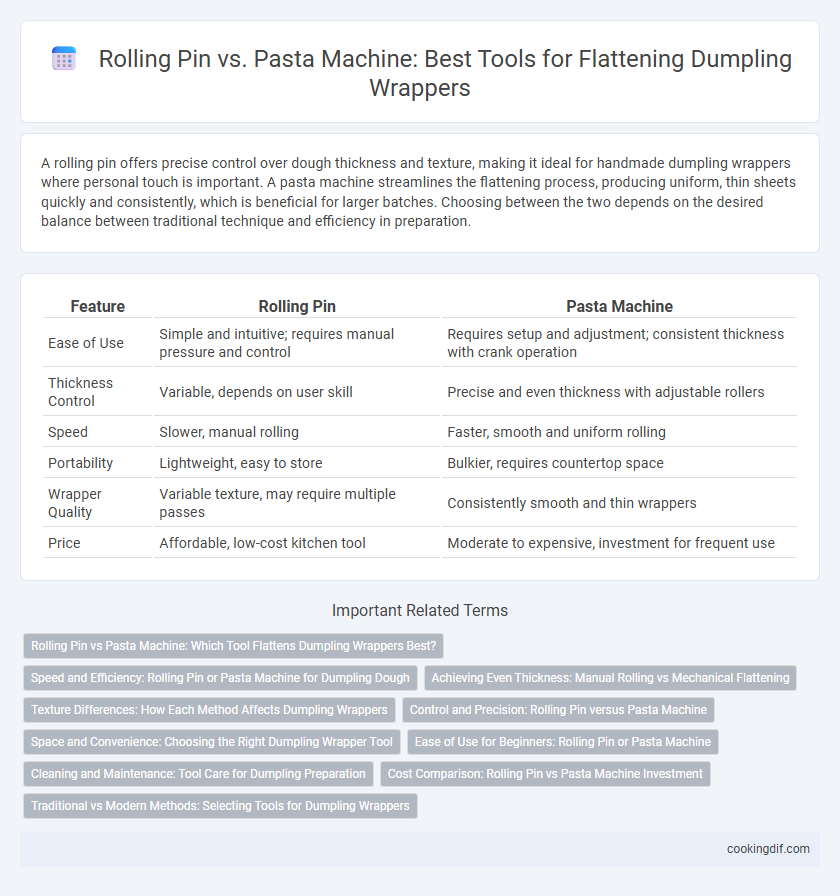A rolling pin offers precise control over dough thickness and texture, making it ideal for handmade dumpling wrappers where personal touch is important. A pasta machine streamlines the flattening process, producing uniform, thin sheets quickly and consistently, which is beneficial for larger batches. Choosing between the two depends on the desired balance between traditional technique and efficiency in preparation.
Table of Comparison
| Feature | Rolling Pin | Pasta Machine |
|---|---|---|
| Ease of Use | Simple and intuitive; requires manual pressure and control | Requires setup and adjustment; consistent thickness with crank operation |
| Thickness Control | Variable, depends on user skill | Precise and even thickness with adjustable rollers |
| Speed | Slower, manual rolling | Faster, smooth and uniform rolling |
| Portability | Lightweight, easy to store | Bulkier, requires countertop space |
| Wrapper Quality | Variable texture, may require multiple passes | Consistently smooth and thin wrappers |
| Price | Affordable, low-cost kitchen tool | Moderate to expensive, investment for frequent use |
Rolling Pin vs Pasta Machine: Which Tool Flattens Dumpling Wrappers Best?
A rolling pin offers precise control and flexibility, allowing dumpling wrappers to be flattened to the desired thickness and shape with ease. Pasta machines ensure uniform thickness and faster processing, making them ideal for consistent wrapper size in large batches. For small-scale, artisanal dumpling preparation, a rolling pin is often preferred, while commercial or high-volume cooking benefits from the efficiency of a pasta machine.
Speed and Efficiency: Rolling Pin or Pasta Machine for Dumpling Dough
Using a pasta machine to flatten dumpling dough significantly increases speed and efficiency by producing uniformly thin wrappers quickly and with minimal effort. A rolling pin requires more manual control and time, often leading to inconsistent thickness and slower preparation. For large batches, a pasta machine optimizes workflow and maintains dough quality, making it the preferred choice for efficient dumpling wrapper production.
Achieving Even Thickness: Manual Rolling vs Mechanical Flattening
Achieving even thickness in dumpling wrappers relies heavily on the tool used; a rolling pin offers tactile control, allowing skilled users to manually adjust pressure for uniform dough sheets. Pasta machines provide mechanical consistency through adjustable settings that produce standardized thickness with minimal effort, reducing the risk of uneven spots. For maximum precision, pasta machines are preferable in high-volume settings, while rolling pins remain ideal for artisan, small-batch preparation.
Texture Differences: How Each Method Affects Dumpling Wrappers
Using a rolling pin allows for greater control over the thickness and texture of dumpling wrappers, resulting in a variety of handcrafted, slightly uneven edges that enhance bite and mouthfeel. A pasta machine produces uniformly thin, smooth wrappers with consistent elasticity, ideal for delicate dumpling skins requiring precise thickness. The choice between rolling pin and pasta machine directly impacts the dumpling's texture, with hand-rolled wrappers offering rustic chewiness and machine-rolled sheets providing tender, silky surfaces.
Control and Precision: Rolling Pin versus Pasta Machine
A rolling pin offers greater control and precision for flattening dumpling wrappers, enabling users to adjust thickness manually and shape edges with ease, which is crucial for delicate, hand-crafted dumplings. Pasta machines provide uniform thickness through adjustable rollers but may lack the nuanced control needed for customized wrapper thickness or irregular shapes. For culinary artisans emphasizing texture and craftsmanship, the rolling pin remains the preferred tool over pasta machines.
Space and Convenience: Choosing the Right Dumpling Wrapper Tool
A rolling pin offers versatility in flattening dumpling wrappers while requiring minimal storage space, making it ideal for small kitchens and easy cleanup. Pasta machines provide precise thickness control and faster production but demand more counter space and setup time. Select a rolling pin for simplicity and compactness or a pasta machine for efficiency and uniform results based on kitchen size and frequency of use.
Ease of Use for Beginners: Rolling Pin or Pasta Machine
A rolling pin offers greater ease of use for beginners when flattening dumpling wrappers, providing simple control over thickness without complex settings. Pasta machines require more skill to adjust rollers and feed dough evenly, which can be challenging for novices. Rolling pins also allow for more flexibility in wrapper size and shape, making them a preferred choice for those new to dumpling making.
Cleaning and Maintenance: Tool Care for Dumpling Preparation
A rolling pin requires minimal cleaning, often just a quick wipe or gentle rinse, making it low-maintenance for dumpling wrapper preparation. Pasta machines demand thorough cleaning after each use to prevent dough buildup, including disassembling and brushing the rollers, which can be time-consuming. Proper care of either tool extends durability, but a rolling pin offers simpler maintenance ideal for frequent dumpling makers.
Cost Comparison: Rolling Pin vs Pasta Machine Investment
A rolling pin offers an affordable option for flattening dumpling wrappers, typically costing between $10 and $30, making it accessible for home cooks on a budget. Pasta machines, priced from $50 to over $100, represent a higher initial investment but provide consistent thickness and efficiency for frequent dumpling makers. Choosing between the two depends on balancing cost constraints with the desired convenience and precision in wrapper preparation.
Traditional vs Modern Methods: Selecting Tools for Dumpling Wrappers
A rolling pin offers precise control and is favored in traditional dumpling wrapper making for achieving the desired thinness through manual effort, preserving the authentic texture. Pasta machines provide uniform thickness quickly, catering to modern preferences for efficiency and consistency in wrapper preparation. Choosing between these tools depends on balancing the value of traditional craftsmanship against the convenience of modern kitchen technology.
Rolling pin vs Pasta machine for flattening wrappers Infographic

 cookingdif.com
cookingdif.com